PLEASE NOTE – This is a very old article and many links are no longer valid. We apologize for any issues you may experience.
In late January 2000, I revisited Arches and Canyonlands National Park after an absence of 4 years. I also spent considerable time at Dead Horse State Park, a less known but equally beautiful site in the same area.
After my first visit, I wrote an article for PHOTO.NET which can be found reprinted here (no longer available). I won’t repeat the travel-related information here, and much of the technical information is now dated, but if you’re interested in more than just viewing the photographs in this section, and would like to visit these wonderful photographic venues, you’ll probably enjoy reading my original article as well No longer available this was written in 2000 and links have been discontinued.
This new trip was at an unusual time of year — mid-winter. One advantage of choosing this time of year was that there are very few tourists. Some days, though we hiked many popular trails, we wouldn’t see another soul for hours at a time.
We had chosen mid-winter, in part because we had hoped for snow. Snow on red-rock creates some wonderful photographic opportunities, but though we had weather, snow wasn’t among the forms of precipitation encountered. During our first 3 days, we had mainly overcast conditions with on-and-off rain. While you might think that this would have cramped our shooting opportunities, just the opposite proved true. More on this later.
There is also a separate page of panoramic images (no longer available)from this trip taken with the Hasselblad XPan.
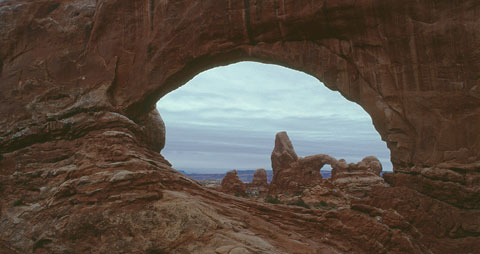
First light on our first day in Arches found us on a high ledge shootingTurret Arch. We’d hoped for some sun but the day dawned overcast. Even so, watching the day begin in this area of isolated splendor was not to be missed.
Photographed with a Rollei 6008i and 40mm Schneider Super Angulon lens on Provia 100F
There were four of us in the shooting party. Steve Kossack— a friend and fellow Southwestern landscape enthusiast, and Alain Briot— an Arizona based fine-art landscape photographer who makes his living from his work. The fourth member of our party was Chris Sanderson, an old friend, and filmmaker who is working with me to create a new multi-media photographic journal. (More on this in the not-to-distant future).
It rained on and off during the first three days and so the weather was highly variable. Consequently, we were frequently shooting on the edges of weather — those times when a storm moves in or out of the area. In fact, we often found ourselves chasing the light, especially when shooting in the Needles section of Canyonlands.
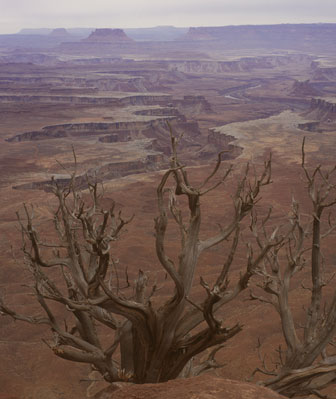
Though this type of image is now somewhat of a clichÈ it is still striking because of the depth perception and perspective of this unique viewpoint. The dead tree is roughly the height of a man, and the canyon floor is about 1,000 feet below the cliff we were standing on.
Photographed with a Rollei 6008i and 90mm Schneider APO-Makro lens on Fuji Provia 100 F.
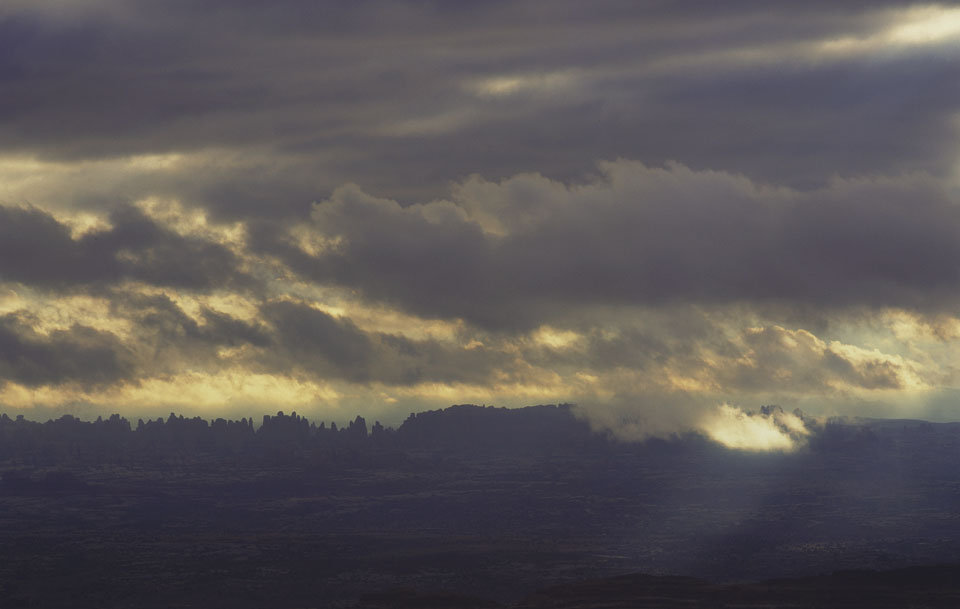
I like this photograph because it captures the drama of winter light and weather in the canyon-lands of southern Utah. But, it lacks a clear focal point. Interestingly, the larger the print that I make of this image, the better it looks. A big print (13 X 18″) makes the clouds that much more dramatic.
Photographed with a Rollei 6008i and 300mm Schneider Apo-Tele Xenar lens on Fuji Provia 100 F.

The sweep of the Colorado River as it runs through Dead Horse State Park is difficult to capture in a photograph. Rather than to try and do so with a panoramic shot I found this tree whose shape mirrors the gooseneck a thousand feet below. The soft light of a late winter day muted the high contrast normally found in this location, though I did have to crank up the contrast and colour saturation a bit — it was too soft.
Photographed with a Rollei 6008i and 40mm Schneider Super-Angulon lens on Fuji Provia 100 F.
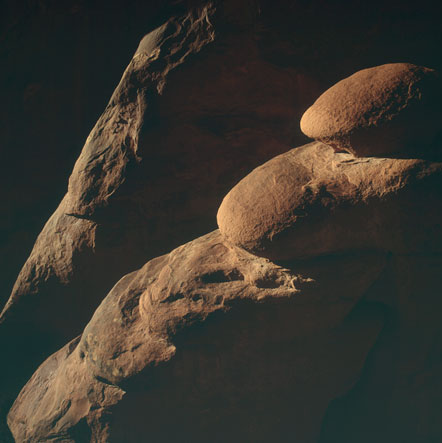
Mid-morning on our fourth and final day found us in Arches hiking to one of the arches (which turned out to be inaccessible due to rock slides). Along the way I found these side-lit rocks, resembling loaves of bread.
Photographed with a Rollei 6008i and 40mm Schneider Super Angulon lens on Fuji Provia 100 F.
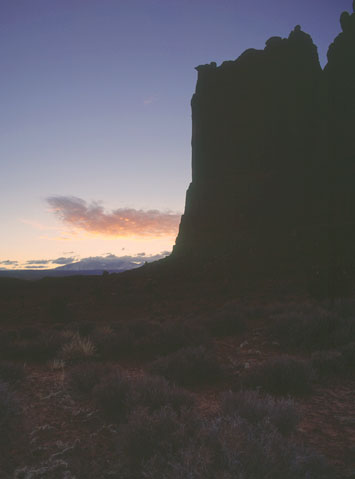
While waiting for sunrise at the Courthouse Wash area of Arches we watched what were to be the day’s only clouds form and then dissipate about 20 minutes before the sun rose behind the distant La Sal mountains. A split neutral density filter with a 30 second exposure allowed capturing the faint detail in the foreground. This is best seen on a large print.
Photographed with a Rollei 6008i and 180mm Schneider Tele-Xenar lens on Provia 100F

The heavy rains of the previous day had left numerous pools of water in a spot called Pothole Point in the Needles district of the park. (Most of the year this area is bone-dry, so we were fortunate to be there when they were filled with water).
We wandered the area for some time, shooting the pools and reflections, when I remembered my Cokin B/Ypolarizer. This is a filter that I rarely use, but Steve Kossack, who introduced me to this unique tool had said, “If you’re shooting water — reach for the B/Y“. I did, and this was the result.
Though I shoot with the 6X6cm square format I usually crop the image to whatever aspect ratio works best for that image. Interestingly, this photograph works well cropped horizontally across the middle and also vertically. But I was so selective in my framing when I shot it that I can’t bear to alter the proportions.
Squares are inherently restful shapes, but combined with the tension created by the exaggerated colours makes this an arresting image.
Photographed with a Rollei 6008i and 40mm Super Angulon lens on Provia 100F with a Cokin B/Y polarizer.
For a completely different image taken in the same place at the same time by Alain Briot, click here.
While my primary camera for this shoot was the Rollei 6008I also brought along the Hasselblad XPan, and I’m glad that I did. The vistas available in each of these parks really lent themselves to the panoramic format.
I have therefore created a separate page of panoramic images from this trip.
If you enjoyed this Gallery and commentary you might wish to read an article that I wrote on my previous visit to Southern Utah in 1996. While much of the technical information is dated, the travel commentary is still valid.
Southwest landscape photographers Steve Kossack and Alain Briot, who accompanied me to Utah also have image galleries from this trip. You may be interested in viewing their work and comparing all three of our styles and approaches to photographing the landscape.
Edited – 12/12/17
You May Also Enjoy...
Cottonwood Parking Site
Watchman of the Cove© Miles HeckerCLICK ABOVE IMAGE TO SEE GOOGLE MAP LOCATIONSEASONS The Coyote Buttes area is typical of the high southwestern desert. Summer
